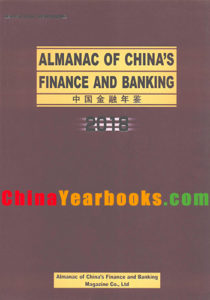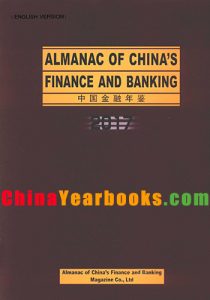ALMANAC OF CHINA’S FINANCE AND BANKING 2018 Download
Yearbook title:中国金融年鉴(英文版)2018
Yearbook English title:ALMANAC OF CHINA’S FINANCE AND BANKING 2018
Published Date :02/2019
Language : English
ISSN:1007-5607
Availability : Printed Version;Electronic Version(PDF Version)

On October 18,2017,the 19th CPC National Congress,an important meeting leading China to the great rejuvenation,was successfully held. In the report delivered at the 19th National Congress of the CPC,President Xi Jinping made the major political judgment that socialism with Chinese characteristics has entered a new era,and he also pointed out that the principal contradiction facing the Chinese society in the new era has evolved into the contradiction between unbalanced and inadequate development and the peopled ever-growing needs for a better life. As China’s economy has shifted from a stage of high-speed growth to a stage of high-quality development,the new development philosophy must be implemented,so as to promote the transformation in quality,efficiency and driving force in the economic development,and to continuously enhance the innovation and competitiveness of China’s economy. The financial sector will firmly implement the spirit of the 19th CPC National Congress,while implementing the overall arrangements of the National Financial Work Conference and the Central Economic Work Conference. Under the guidance of Xi Jinping Thought on Socialism with Chinese Characteristics for a New Era,by acting in response to the evolution of the major contradictions in Chinese society and changes in the stage of economic development,the financial sector will implement the new development philosophy in a decisive way to promote the financial reform and opening up with great efforts,and to provide strong financial support for the high-quality development of the economy! Firmly implementing a new development philosophy,with serving the supply-side structural reform as the main task,and providing support for the high-quality development of the real economy. Byworking around the five tasks of reducing excess capacity,destocking,deleveraging,lowering costs,and shoring up weak spots,the PBC appropriately dealt with corporate debts of the overcapacity industries through the establishment of the creditors’ committee and market-based debt-for-equity swaps. Meanwhile,guidance was offered to banking financial institutions to ensure that rational financing needs of the steel and iron as well as coal industries with excess capacity can be met when they pursued transformation,based on the principle of differentiated treatment by supporting some while suppressing others. This move was aimed at supporting good enterprises,stabilizing problem enterprises,and exiting “zombie enterprises”. The Guiding Opinions on Providing Financial Support for Building China into a Manufacturing Power was issued to increase financial support for the construction of a manufacturing power. Financial support for major national strategies was also intensified,including the coordinated development of Beijing,Tianjin and Hebei province,development of Xiong ‘ an New Area,growing into a maritime power,military-civilian integration ? and development of the Belt and Road Initiative. At the end of 2017,loans to the infrastructure sector increased by 15.7%,while loans to the strategic emerging industries of 21 major banks increased by 10.1%,and the growth rate of loans to the manufacturing industry turned positive from negative. Qualified manufacturers were encouraged to finance through China^s multi-tiered capital markets. In 2017,there were331 IPOs made by manufacturing companies for a combined 163.54 billion yuan and follow-on offerings for 299.95 billion yuan,and a total of 5 804 manufacturing companies had been admitted onto the NEEQ,accounting for 50% of the NEEQ market,and 1 223of which secured 57.03 billion yuan in financing through stock issue Financial services for science and technology innovation,culture industry,and new types of consumption were deepened to actively foster new growth drivers. At the end of 2017,outstanding medium and long-term loans to scientific research and technological services,culture and sports,and the entertainment industry stood at 364.2 billion yuan.Nine mass innovation and entrepreneurship debt financing instruments were registered with a total value of 17 billion yuan. Giving priority to focusing on key issues,addressing weak links,and strengthenii^weakness for the purpose of providing support for prevention and mitigation of major risks,targeted poverty alleviation,and prevention and control of pollutio Reinforcing the financial risk firewall to firmly safeguard the bottom line of preventing systemic financial risks. In 2017,the financial sector actively and steadily promoted deleveraging to prevent and mitigate the risk of high leverage in a practical way. The PBC issued the Guiding Opinions on Regulating the Asset Management Activities by Financial Institutions to set down single standards and regulations for key issues arising from asset management,including multiple packaging,unclear leverage,regulatory arbitrage,and implicit guarantee. Efforts were made to formulate measures for supervising and regulating financial holding companies,and the Opinions on the Regulation of Investment by Non-financial Enterprises in Financial Institutions was rolled out to prevent the risk cross-contagion between financial and real sectors. The PBC promoted the specific program to manage Internet finance risks,and facilitated the establishment of a long?term mechanism for Internet finance regulation and risk prevention. The PBC strictly rectified the irregularities in the financial market by intensifying financial supervision and regulation and maintaining high pressure on law enforcement. The PBC firmly focused on financial services for targeted poverty alleviation,improved the development level of inclusive finance,and provided support for the implementation of the strategy of rural revitalization. The PBC released the Opinions on Providing Financial Support to the Battle against Poverty in Deeply Impoverished Regions,launched the pilot reform of interest rate pricing mechanism for poverty alleviation central bank lending,and issued innovative debt financing instruments such as poverty alleviation social impact bonds and poverty alleviation bills. The pilot reform of inclusive finance was steadily advanced,the financial institution system and policy system serving the grass roots were greatly improved,and the efficiency of service of the agro-related social credit system and payment system was significantly enhanced The reform of green finance was steadily pushed forward to produce sustainable economic,social and environmental benefits. The infrastructure construction of green finance was continuously strengthened,including policy framework,standard system,statistical system,information disclosure requirements,green evaluation,and evaluation certification. The pilot reform of green finance witnessed positive progress in the continuous product and service innovation. The market size of green financial expanded rapidly,providing strong financial support for the green transformation of the real economy. Deepening the reform of the financial system,improving and making iiuiovation in the macro-control mechanism,enhancing the financial supervision system,and promoting the sound development of the financial market. A two-pillar regulatory framework of monetary policy and macro-prudential policy was preliminarily established. On the one hand,the PBC promoted the shift of monetary policy framework from mainly relying on quantitative instruments to mainly relying on price instruments in a proactive and prudent manner. To achieve it,the PBC developed numerous monetary policy tools,and kept liquidity basically stable. On the other hand,the PBC made great efforts for developing and improving its macro-prudential policy framework. In 2016,the dynamic adjustment mechanism of the differentiated reserve requirement ratios was upgraded into the MPA system. Afterwards,the off-balance sheet wealth management and interbank certificates of deposit were included in the MPA indicator assessment,and the cross-border capital flows and the real estate market were also included in the macro-prudential regulation. The combination of monetary and macro-prudential policies will help promote financial stability while maintaining the value of the Renminbi,create a neutral and adequate monetary and financial environment for the supply-side structural reform,and prevent systemic financial risks in an even better fashion The financial supervision system was improved to enhance the efficiency of supervision. In November 2017,the Financial Stability and Development Committee under the State Council(hereinafter referred to as the “ FSDC ”)was formally established. The FSDC is a deliberative and coordinating organ under the State Council for the overall planning and coordination of the major issues regarding the financial stability and reform and development. Its establishment will help achieve full coverage of macro-prudential management and financial supervision on all types of financial institutions,business,activities,and their risks,will eliminate the neglected aspects of supervision and improve the effectiveness of supervision,and will be of great significance for accelerating the establishment of a powerful and efficient modern financial supervision framework,supervision rules and regulations as well as supervision standards. The institution building of the financial market was strengthened,and a robust multi-tiered financial market system was built. The market-making mechanism of the interbank bond market was improved by launching the bidding for financial bond swap on a trial basis as a move to diversify means of issuance,which will help increase the overall market liquidity and market rate stability. The Measures for the Administration of Securities Offering and Underwriting was revised,the mechanism of Public Offering Review Committee was reformed,and the delisting rules were further recalibrated.Market tiering and reform of trading rules for the NEEQ made major breakthroughs,with the introduction of call auction trading and differentiated matchmaking,disclosure and supervisory arrangements,all aimed at bolstering price discovery. With the release of the Trial Measures for the Supervision and Administration of Regional Equity Trading Platforms,consolidated business rules and regulations were set out,formally incorporating regional equity trading platforms into China’s multi-tiered capital markets. Focusing on providing support for the development of the Belt and Road Initiative to promote the formation of a new layout of financial opening up. A multi-tier investment and financing framework was built to provide financial support for the development of the Belt and Road Initiative. In May 2017,the first Belt and Road Forum for International Cooperation was held in Beijing,which produced a series of important outcomes. The overall plan for providing financial support for the development of the Belt and Road Initiative was formulated and released. The equity investment funds such as the Silk Road Fund was successfully put into operation,the advantages of the development finance were given full play in the development of the Belt and Road Initiative,and the network layout of financial institutions and services in the Belt and Road countries was continuously promoted. The circulation of funds in the capital market was further deepened. The governments and higher-credit enterprises and financial institutions of the Belt and Road countries were supported to issue the Renminbi-denominated bonds in China. The financial market opening-up and the Renminbi internationalization were promoted in a steady and orderly manner. The PBC continued to explore two-way financial market opening-up through infrastructure connectivity,and it launched the Bond Connect jointly with the Hong Kong Monetary Authority(HKMA). As of the end of2017,a total of 249 overseas institutions accessed China’s interbank bond market through the Bond Connect with bond holdings exceeding 80 billion yuan. The panda bond issuers were diversified,expanding from overseas non-financial enterprises to foreign government institutions,international development agencies,and overseas financial institutions and non-financial enterprises. China’s A-shares were included in the MSCI Emerging Markets Index. The review mechanism for follow-on offerings by domestic companies on overseas markets was further optimized,and the pilot program of H-share full circulation was launched. As of the end of 2017,a total of 806 overseas institutions had gained access to China’s interbank bond market. The pilot of RQFII was expanded to 18 countries and regions with a total investment quota of 1.74 trillion yuan. The domestic Renminbidenominated financial assets held by overseas entities in the form of equities,bonds,loans,and deposits stood at 4.29 trillion yuan,soaring 41.3% year on year In the past year,under the leadership of the Party Central Committee and the State Council,China’s financial industry achieved a steady development,providing strong support for the transformation and high-quality development of its economy. By adhering to the historical responsibility of preservation of history and inheritance,The Almanac of China’s Finance and Banking faithfully recorded the course of reform and development of Chinas financial industry in the past year,with a view to benefiting readers in learning from history,carrying on the past and opening a way for future,and opening a new chapter in the reform and development of Chinafinancial industry in the new era!
